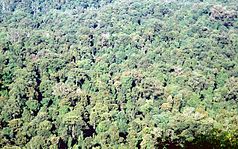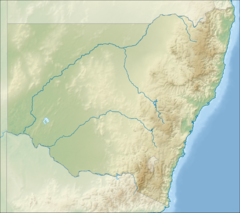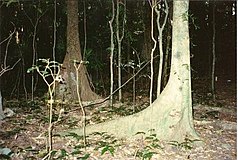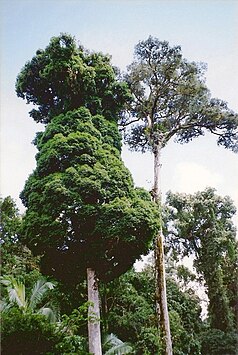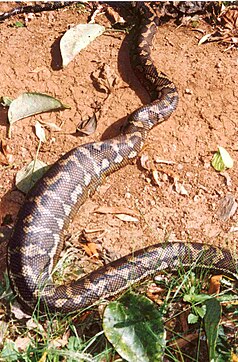Toonumbar National Park
| Toonumbar National Park | ||
|---|---|---|
| Subtropical rainforest in Toonumbar National Park | ||
|
|
||
| Location: | New South Wales , Australia | |
| Specialty: | Gondwana rainforest, eucalyptus forest, ancient volcanoes | |
| Next city: | Toonumbar, Ulidia | |
| Surface: | 149.1 km² | |
| Founding: | December 22, 1995 | |
| Black and white booyong ( Argyrodendron actinophyllum / trifoliolatum ) | ||
| Syzygium francisii (left) and Argyrodendron trifoliolatum (right) | ||
| A carpet python ( Morelia spilota mcdowelli ) devours a prey in Toonumbar National Park | ||
The Toonumbar National Park is a national park in the far northeast of the Australian state of New South Wales , 617 km north of Sydney and 65 km north-west of Lismore .
The park has Gondwana rainforests , which have been a World Heritage Site since 1986 and were added to the Australian list of natural monuments in 2007.
description
The subtropical rainforests are habitat for endangered plants and animals, e.g. B. the Sooty Owl ( owl ), the Rotbeinfilander and the yellow-bellied glider . The rainforests on Dome Mountain and Murray Scrub are part of the Gondwana rainforests in eastern Australia, which are listed as World Natural Heritage. The wild area around Mount Lindesay , Dome Mountain and Edinburgh Castle have inspired legends for many Aborigines .
In addition to the rainforests, there are also cooler and drier places in the park that shine with a particularly species-rich flora, from light eucalyptus forests to dense forests with tall eucalyptus trees to forests with Bangalow Palms (Archontophoenix cunninghamiana).
The animal world awaits with species such as the marble swallow ( Podargus ocellatus ), the koala , the brown-backed lyre-tail and reptiles and frogs typical of the rainforest. The rainforest is an important refuge for fruit-eating pigeons and insect-eating bats. Filanders also live there.
In the park there are focal peak volcanoes (which were active 23 million years ago and of which a steep basalt column has remained in place of the central crater). The weathered volcanic remains of Mount Lindesay , Dome Mountain and Edinburgh Castle shape the landscape today. The high amounts of rain and the fertile soil have created a unique rainforest on its slopes.
On average, it rains 1035.8 mm annually in the park. The highest daily rainfall so far was 449.4 mm.
Land rights of the indigenous people
The Githabul also successfully raised claims in the area of the Toonumbar National Park . Trevor Close , an Aboriginal attorney, fought the New South Wales government for 15 years until he won the lawsuit in memory of his grandfather, Rory Close . There are a number of Jurabihls (holy places) in Toonumbar National Park . Dome Mountain is Githabul's sacred place for rain. Edinburgh Castle is a Goanna place and belongs to the Williams people who live in the Muli Muli Aboriginal reservation , which is about 10 km west of the town of Woodenbong .
Web links
- Toonumbar National Park . NSW Environment & Heritage Office
- List of animals in Toonumbar National Park. WildlifeAtlas.NationalParks.nsw.gov.au
Individual evidence
- ^ Steve Parish: Australian Touring Atlas . Steve Parish Publishing Pty. Ltd. Archerfield QLD (2007). ISBN 978174193232-4 . P. 29
